Treasured recipes: Margaret Fulton's pavlova, roast chicken, quiche and more
Updated , first published
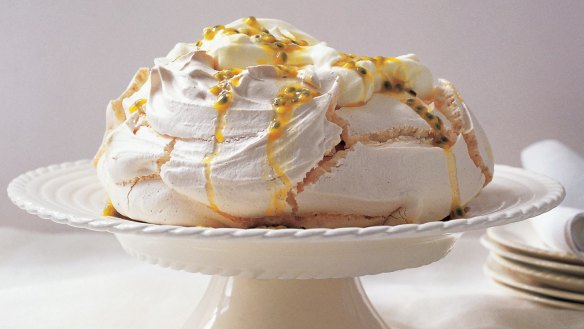
Margaret Fulton, who died last week at 94, was our every day cook, the one you turn to for Thursday's fish dinner or a weekend treat. She wasn't snobbish about food; she was sensible, practical and helpful; a natural teacher.
In an entrepreneurial move by publisher Paul Hamlyn, her Margaret Fulton Cookbook burst on the scene in 1968, its pages sparkling with colour photographs both educated and inspired. In that it sold 1.5 million copies, and she went on to write a further 20 cookbooks, it's fair to say that Margaret Fulton taught Australia how to cook.
Her genius – her business model, if you like – was to introduce Australians to the great recipes of the world in a way that didn't scare or patronise. Recipes for meatloaf sat next to filet de boeuf en croute, and tuna macaroni next to lobster newburg.
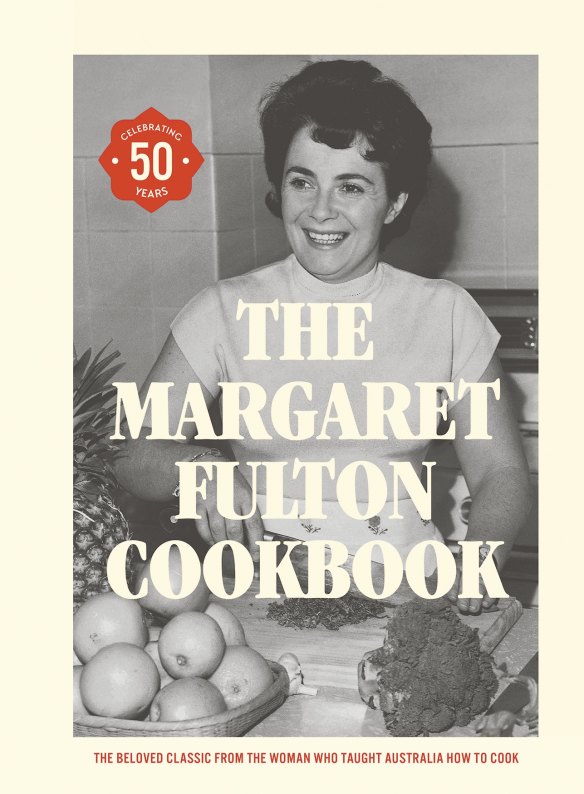
In 1968, my mother was cooking for a family of six, discovering new recipes and ingredients that went beyond roast lamb, mashed potatoes and peas. "She opened up a whole new scene for us," recalls Mum. "Her recipes were so popular that they made available so many ingredients we had never seen before."
Margaret Fulton is one of the "mothers" of Australian cookery, along with Stephanie Alexander, Maggie Beer, Charmaine Solomon, Diane Holuigue, Joan Campbell, Elizabeth Chong and so many more.
You can open any of her books at any page and cook something for tonight's dinner. The recipes here – the perfect scone, the almighty pavlova, an entirely new (for then) technique for roasting chicken, and a nasi goreng typical of her border-crossing international spirit – will resonate with those who grew up with them, and make a fine introduction for those who didn't.
It's fair to say that Margaret Fulton taught Australia how to cook.
Margaret Fulton may have gone, but her recipes live on. Thank you, Margaret.
Jill Dupleix
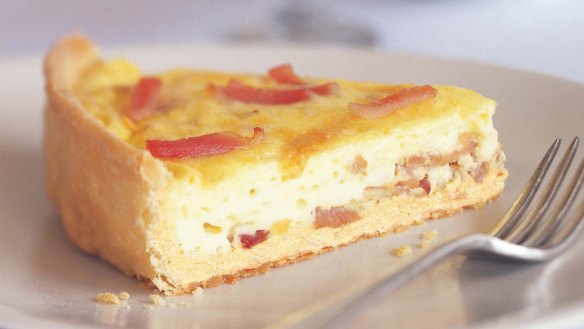
Quiche lorraine
The classic quiche lorraine contains no cheese, but a few tablespoons of grated cheese can be added to the egg mixture, if desired. The flan ring lined with pastry may be made well ahead of time and chilled while the filling can also be prepared and stored in the fridge.
INGREDIENTS
3-4 rashers bacon
1 shortcrust flan case, baked blind (recipe below)
2 eggs
1 tsp plain flour
a pinch of ground nutmeg
½ tsp salt
a pinch of cayenne pepper
½ cup each cream and milk
METHOD
1. Trim the rind off the bacon and grill or fry until crisp. Cut into bite-sized pieces. Place in pastry case.
2. Preheat the oven to 190C.
3. Beat together the eggs, flour, nutmeg, salt, cayenne, cream and milk, only until combined (over-beating causes bubbles on top). Strain over the bacon and bake for 10 minutes.
4. Reduce heat to moderate 180C and bake a further 20 minutes, or until a knife inserted in the custard comes out clean. Serve warm.
Serves 4-6
Shortcrust flan case
INGREDIENTS
1 cup plain flour
a pinch of salt
60g butter
1 egg yolk
2 tbsp iced water
a good squeeze of lemon juice
METHOD
1. Preheat the oven to 190C. Sift the flour and salt into a bowl. Cut the butter into small pieces and rub lightly and evenly in the flour, until the mixture resembles breadcrumbs. Beat the egg yolk, one tablespoon of water and the lemon juice together then sprinkle evenly over the flour, stirring with a spatula or knife to form a dough. Add a little extra water if necessary. Knead lightly on a floured board, wrap in cling wrap and chill for one hour, or until required.
2. Roll out on a lightly floured board to fit 20-23cm fluted flan ring.
3. Press pastry well into the fluted edge, being careful not to stretch it. Using a sharp knife, cut away the excess pastry so it is level with the top of the flan ring. Prick the base lightly with a fork. Line the pastry with a piece of greaseproof paper and half-fill with pie weights or dried beans. Chill for a further 15 minutes then bake for 10 minutes. Remove from the oven, remove the paper and beans and cool while preparing the filling. If not to be baked with filling, return to the oven for another five to 10 minutes until golden.
Note: the flan case may be brushed with a little egg white before baking, if desired, as an extra precaution against the filling seeping through.
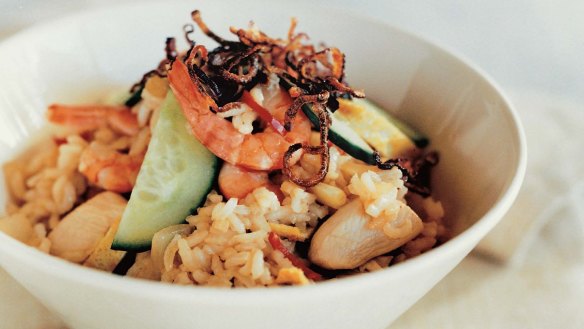
Nasi goreng
INGREDIENTS
2 cups rice
4 cups water
1 tsp salt
½ cup peanut or vegetable oil
2 onions, chopped
½ tsp dry shrimp paste (trasi or blachan)
1 clove garlic, crushed
1 fresh chilli, seeded and sliced
250g beef or pork fillet, diced
2 half chicken breasts, diced
250g prawns, shelled
2 tbsp light soy sauce
4 eggs
Optional garnishes
crisp fried onion
fried egg
slices of unpeeled Lebanese cucumber
small fried meatballs served on skewers and topped with a little chilli sauce
fried sardines
fried pappadums or prawn crisps fried in oil
METHOD
1. Wash the rice in several changes of water. Bring the water to the boil, and then add the salt and rice. Reduce the heat, cover tightly, and simmer for 20 to 25 minutes. Uncover, and allow to get quite cold. It is a good idea to cook the rice the day before.
2. Heat half the oil in a large frying pan. First fry the onions, shrimp paste, garlic and chilli, stirring constantly, for two to three minutes. Add the beef or pork and fry until cooked, about
three to four minutes. Add the remaining oil when necessary. Add the chicken and prawns and cook two minutes longer, then add the rice and fry, stirring constantly, until heated through and the rice is golden. Sprinkle with soy sauce and toss together well.
3. Fry the eggs individually, or prepare an omelette separately and cut into thin strips. Heap the rice on a serving plate and garnish with the eggs or omelette strips.
Serves 4
French roast chicken
INGREDIENTS
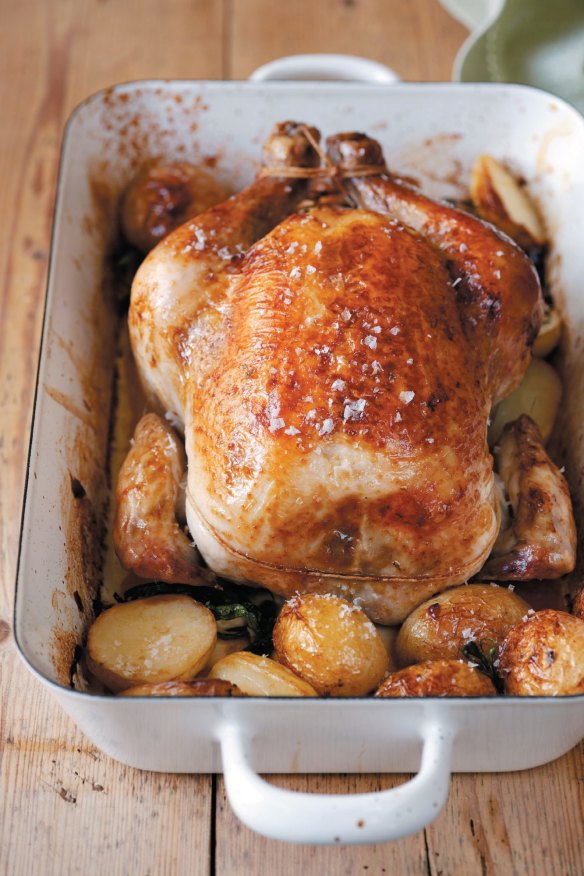
1 size 18 (1.8 kg) chicken
60g butter
salt and freshly ground pepper
a good pinch of dried tarragon or fresh parsley stalks
a few strips of orange or lemon rind
2 cups chicken stock
METHOD
1. Preheat the oven to 190C. Wipe the cavity of the chicken with a paper towel. Remove excess fat. Place a little butter, a little salt and pepper, tarragon or parsley stalks and strips of orange or lemon rind inside chicken cavity. Truss with string.
2. Wipe outside of bird, spread with remaining butter and place breast-side up in a small baking dish, preferably on a rack. Pour one cup of water in with half a cup of the stock and place in the oven for 10 minutes, basting once or twice with the liquid underneath. Turn on side and baste well with stock.
3. Continue to cook for a further 20 minutes, basting and adding more stock as necessary. Turn chicken to other side and cook, basting for a further 20 minutes.
4. Turn bird on its back a further 15 minutes or so to brown the breast. There should be just enough stock to keep the juice in the dish from scorching, if not add more water. To test, run a fine skewer into the thigh joint of the chicken. If the juice that runs out is clear and colourless, the chicken is cooked. Take chicken from dish and remove string. Keep in a warm place.
Gravy: Pour off all but two tablespoons fat from the dish. Add one tablespoon flour and stir well until lightly browned. Add remaining 1½ cups chicken stock, stir until thickened. Season with salt and pepper.
Cream gravy: Make as above but just before serving stir in three tablespoons cream and cook a little until thickened.
Serves 4-5
Pavlova
INGREDIENTS
4 egg whites
a pinch of salt
1½ cups castor sugar
1½ tsp vinegar
1 tsp vanilla
300ml cream, whipped
pulp of 3 passionfruit or 1 cup sliced strawberries
METHOD
1. Preheat the oven to 200-210C. Place a piece of baking paper on a baking tray and mark a 20cm circle (the pavlova will spread a little).
2. Beat the egg whites and salt in an electric mixer until they stand in stiff peaks. Sift the sugar and gradually sprinkle in one tablespoon at a time, beating at full speed only until all sugar has been added.
3. Lastly, fold in the vinegar and vanilla. Spoon large dollops inside the circle on the baking sheet and smooth over the top lightly. Place in the oven (reducing the temperature to 150C) for one hour. Turn off the heat and leave pavlova in the oven until cold. If using a gas oven, bake at 150C for one hour, reduce heat to 120C for a further 30 minutes and then turn oven off and leave the pavlova in oven until completely cooled.
4. When pavlova is cooled, slide onto a large, flat cake plate and remove the baking paper. Don't worry if the pavlova collapses slightly, also expect cracks on the surface. Whip the cream until stiff and spoon over the top of pavlova. Spoon over the passionfruit pulp or strawberries to serve.
Serves 8-10
Pumpkin scones
INGREDIENTS
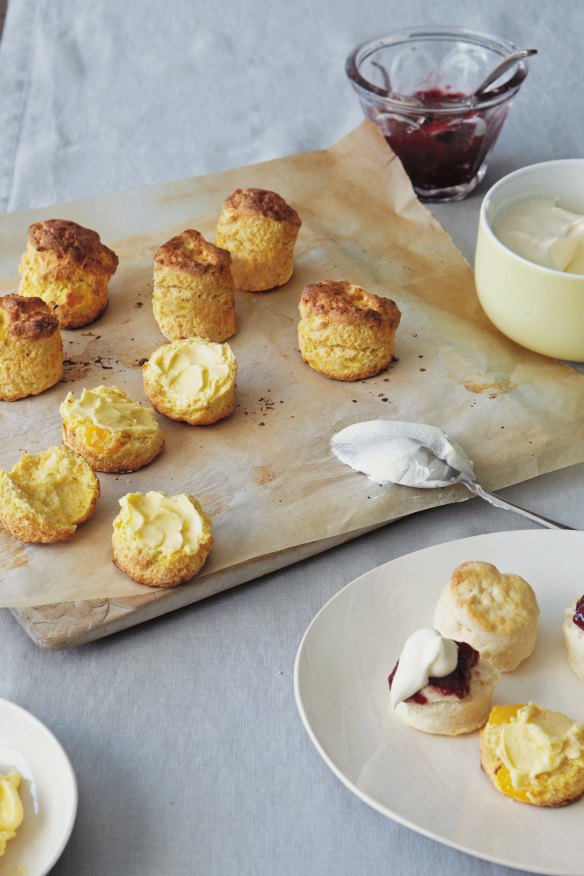
1 cup cooked pumpkin, drained and cooled
2 cups self raising flour
½ tsp salt
30g butter, cut into small pieces
¼ cup castor sugar
1 egg, beaten lightly
extra milk, for glazing
METHOD
1. Preheat oven to 225C. Grease a 23cm sandwich tin with butter.
2. Sift flour and salt into a bowl. Rub in butter, add sugar, pumpkin and egg. Mix into a dough, knead lightly with a little flour. Pat out to 2.5-cm thickness. Cut into 12 rounds.
3. Arrange in prepared sandwich tin. Brush scones with extra milk, bake in preheated oven for 20 minutes, until risen and golden. Remove from oven and wrap in a clean tea towel for a few minutes before splitting and buttering.
Makes about 12
This is an edited extract from The Margaret Fulton Cookbook published by Hardie Grant Books RRP $39.99 and is available in stores nationally; photography © Geoff Lung (scones image by Vanessa Levis and Chris Chen).
From our partners
Original URL: https://www.watoday.com.au/goodfood/margaret-fulton-recipes-20190725-h1gjtf.html